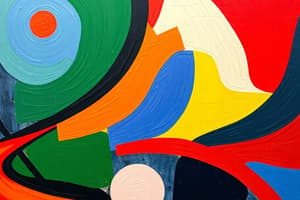Podcast
Questions and Answers
What is one reason for studying art?
What is one reason for studying art?
- To forget the past
- To develop a deeper understanding of the self (correct)
- To rely solely on technology
- To negate human experiences
Which statement best describes the nature of art?
Which statement best describes the nature of art?
- Art is a man-made expression of nature. (correct)
- Art is nature itself.
- Art has no relation to human perception.
- Art is solely an emotional experience.
Which type of art includes complex structures and design?
Which type of art includes complex structures and design?
- Literary arts
- Visual art (correct)
- Gustatory art
- Performing arts
Which type of art is characterized by movement and gestures?
Which type of art is characterized by movement and gestures?
What is a characteristic of an artist?
What is a characteristic of an artist?
Which type of art includes short stories and poetry?
Which type of art includes short stories and poetry?
What is a common misconception about art?
What is a common misconception about art?
What characterizes decorative arts?
What characterizes decorative arts?
Flashcards
Importance of Studying Art
Importance of Studying Art
Studying art helps us connect to history, gain insight into humanity, and articulate thoughts.
Art is Universal
Art is Universal
Art is created by people everywhere and throughout history, reflecting enjoyment and connection.
Art vs Nature
Art vs Nature
Art is a human-made expression, interpreted from nature rather than a replication of it.
Experience of Art
Experience of Art
Signup and view all the flashcards
Types of Visual Art
Types of Visual Art
Signup and view all the flashcards
Performing Arts
Performing Arts
Signup and view all the flashcards
Literary Arts
Literary Arts
Signup and view all the flashcards
Characteristics of an Artist
Characteristics of an Artist
Signup and view all the flashcards
Study Notes
Why Study Art?
- Art allows connection to the past, understanding the world, one's society, and the self.
- Studying art provides insight into the human condition, offering access to different perspectives and broadening thought through time and space.
- Learning to construct meaning and articulate thoughts develops an open mind, promoting understanding of multiple problem-solving approaches.
Assumptions About Art
- Art is universal, created by various people across all time and places. Its existence stems from its appeal and enjoyment.
- Art is man-made; it's a human expression of nature's observations and interpretations. It's a personal take on what is already present in nature.
- Art involves experience. Judging art involves sensing, experiencing through sight and sound, and the involvement of emotion.
Types of Art
- Visual Art: Perceived by sight, including graphic arts (painting, drawing, photography, print media), and plastic arts (sculpture, architecture, industrial design).
- Performing Arts: Involve movement, speech, and gestures, such as theatre, dance, and music.
- Literary Arts: Involve written works – short stories, novels, poetry, and drama.
- Popular Arts: Comprise forms like film, newspapers, magazines, radio, and television. Key characteristic: engaging and lively.
- Gustatory Arts: Skill in preparing food and beverages (cuisine).
- Decorative Arts: Visual objects designed to beautify places (e.g., bowls, chandeliers, furniture). Also known as applied arts.
Characteristics of an Artist
- Artists possess wide or keen imaginations and craft skills.
Studying That Suits You
Use AI to generate personalized quizzes and flashcards to suit your learning preferences.




